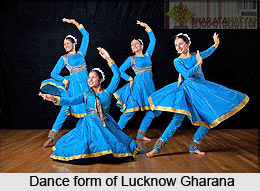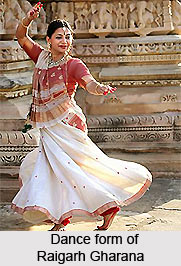 The word "Gharana" literally means "House" and it implies the house of the teacher. It is linked to the very ancient concept of the Guru-Shishya-Parampara (linage of teacher or disciple) but with some interesting modern twists.
The word "Gharana" literally means "House" and it implies the house of the teacher. It is linked to the very ancient concept of the Guru-Shishya-Parampara (linage of teacher or disciple) but with some interesting modern twists.The Gharanas of Kathak are as follows:
Lucknow Gharana
This gharana of Kathak actually developed in the courts of the Nawab of Oudh in Lucknow, Uttar Pradesh. It particularly gives importance to grace, elegance and natural expressions in the dance. Abhinaya or expressional acting, especially improvised, plays a very strong role in this style, and Birju Maharaj, Shambhu Maharaj and Lachhu Maharaj were all famed for the naturalness of and innovativeness of their abhinaya.
Jaipur Gharana
Jaipur Gharana developed in the courts of the Kachchwaha kings of Jaipur in Rajasthan. The significance is placed on the more technical aspects of dance, such as complex and powerful footwork, multiple spins, and complicated compositions in different talas. There is also a greater incorporation of compositions from the Pakhawaj, such as, Parans.
 Banaras Gharana
Banaras GharanaThe Banaras Gharana was developed by Janakiprasad. It is characterized by the exclusive use of the Natwari or Dance bols, which are different from the tabla and the Pakhawaj bols. There are differences in the Thaat and Tatkaar, and Chakkars are kept at a minimum but are often taken from both the right- and the left-hand sides with equal confidence. There is also a greater use of the floor. Though the style developed in Varanasi, today it flourishes in Bikaner.
For more, visit the link below: